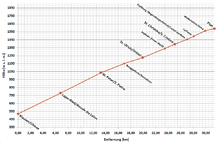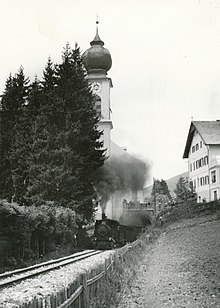Val Gardena Railway
| Klausen plan | |||||||||||||||||||||||||||||||||||||||||||||||||||||||||||||||||||||||||||||
|---|---|---|---|---|---|---|---|---|---|---|---|---|---|---|---|---|---|---|---|---|---|---|---|---|---|---|---|---|---|---|---|---|---|---|---|---|---|---|---|---|---|---|---|---|---|---|---|---|---|---|---|---|---|---|---|---|---|---|---|---|---|---|---|---|---|---|---|---|---|---|---|---|---|---|---|---|---|
| Route length: | 31.00 km | ||||||||||||||||||||||||||||||||||||||||||||||||||||||||||||||||||||||||||||
| Gauge : | 760 mm ( Bosnian gauge ) | ||||||||||||||||||||||||||||||||||||||||||||||||||||||||||||||||||||||||||||
| Maximum slope : | 51 ‰ | ||||||||||||||||||||||||||||||||||||||||||||||||||||||||||||||||||||||||||||
| Minimum radius : | 38 m | ||||||||||||||||||||||||||||||||||||||||||||||||||||||||||||||||||||||||||||
|
|||||||||||||||||||||||||||||||||||||||||||||||||||||||||||||||||||||||||||||
The Val Gardena Railway was a 31 km long, narrow-gauge local railway that ran from the Chiusa station on the Brenner Railway , which is now in the Italian province of South Tyrol , to Val Gardena . The railway, which was closed in 1960, had a Bosnian gauge of 760 mm.
Route
A winding viaduct wound around the starting point at Klausen train station in order to gain as much height as possible. The railway ran along the mountain flank through tunnels and over bridges to Ortisei . A spiral tunnel is still visible in St. Christina today . The route was almost built along the entire length of civil engineering structures - on the one hand to make up for the large difference in height, on the other hand, the partially unfavorable for a railway topography compensate.
history
The railway was built in 1915/16 as an army field railway in a period of four and a half months during the First World War in order to be able to supply the units stationed there with material at the front line to Italy. Up to 10,000 workers were employed in the construction: 500 civilian workers, 3,500 military workers and soldiers, and 6,000 mainly Russian prisoners of war. The department for alignment and construction work was headed by Prof. Dr. Leopold Oerley .
Most of the bridges along the route were initially made of wood in order to put the railway into operation more quickly and only later replaced by stone structures.
On the occasion of the construction of the railway, the Val Gardena sculptor Johann Baptist Moroder (1870–1932) was commissioned by Field Marshal Conrad von Hötzendorf with four large sculptures, Saint Barbara , patron saint of railway workers, the Apostles Peter and Paul and an Austrian imperial eagle made of concrete . The monument was erected above Klausen and was later given a bronze plaque with information on the history of the railway. It was the first concrete sculpture in South Tyrol .
The railway was never particularly powerful and fast. With the emergence of competition from the automobile, this led to a shutdown in 1960. Finally, a section of the former route was converted into a road for the Alpine World Ski Championships in 1970 .
present
The route is still partially available today and is also used as a footpath. A few train stations and engineering structures have been preserved. A planetary path was laid out on the route within the municipality of St. Christina .
In October 2000 the local artist Egon Moroder Rusina exhibited the graphic cycle Dissolution in the tunnel in Ortisei .
In the 1980s, a locomotive of the original Austrian design was set up on a children's playground in Ortisei and in 2008 it was moved to the former train station in Ortisei. A steam locomotive was also set up at Klausen station for a long time. However, this had no connection to the Val Gardena Railway, but came from a southern Italian narrow-gauge line. In the meantime, this locomotive has been replaced by a model of a typical Val Gardena train. The abandoned Kehr viaduct in Klausen is also still there.
In addition, in the lower part of the street Klausen – St. Ulrich built a monument with an eagle sculpture in honor of Conrad von Hötzendorf . At its feet is an old railway viaduct, next to which a new bridge with a larger curve radius was built for the road. The other numerous structures in this section were adapted for road construction, for example by expanding the tunnel profiles.
In 2015, on the initiative of the South Tyrolean regional department for mobility, a feasibility study for reactivating the Val Gardena Railway was commissioned.
vehicles
In 1916, the traffic was received with locomotives from in today's Slovakia situated kúpele narrow gauge railway Ružomberok-Korytnica came. The three locomotives were built by the Budapest locomotive factory MÁVAG and once had the company numbers 1–3 of the Rózsahegy – Korytniczai helyi érdekü vasút (RKV).
gallery
Plaque on the monument to Field Marshal Conrad von Hötzendorf on the route of the railway above Klausen
literature
- Walther Schaumann : The railways between Ortler and Piave in the war years 1915–1918 . Use and performance of the Austro-Hungarian and Imperial German railway formations. Bohmann Verlag, Vienna, Heidelberg 1971.
- Josef Dultinger : Forgotten Past . Narrow gauge railways of the Austro-Hungarian Army on the Dolomite Front 1915–1918. Publishing house Dr. Rudolf Erhard, Rum 1982.
- Piero Muscolino: The Dolomites Narrow Gauge Railways and Travel Memories . Auer – Predazzo, Klausen – Plan. Calosci, Cortona 1988.
- Elfriede Perathoner: La ferata de Gherdëina - The Val Gardena Railway . 2nd Edition. Athesia, Bozen 1997, ISBN 88-7014-687-1 .
- Helene Flöss : Lions in the Wood . Haymon Verlag, Innsbruck 2003, ISBN 3-85218-431-2 (novel, tells about the construction of the Val Gardena Railway).
- Werner Duschk, Walter Pramstaller, among others: Local and trams in old Tyrol . Self-published by Tiroler Museumsbahnen , Innsbruck 2008.
- Vincent Peristi: 50 ani da canche i à tëut demetz la ferata de Gherdëina . In: Union di Ladins de Gherdëina (ed.): Calënder de Gherdëina . Ortisei 2010, p. 11–40 (images, Ladin).
- Railway Atlas of Italy and Slovenia - Atlante ferroviario d'Italia e Slovenia . Schweers + Wall, 2010, ISBN 978-3-89494-129-1 , pp. 110 .
- Elfriede Perathoner, Stefan Planker: Scibla mo 'n iëde . Museum Ladin , San Martin de Tor 2011, ISBN 978-88-89255-33-9 (exhibition catalog in Ladin, German, Italian).
- Contemporary works
- Julius Khu: The construction of the Grödnerbahn 1915–1916 . In: Military Scientific Communications . No. 8 , August 1937, p. 611-629 .
- Leopold Oerley: The new South Tyrolean narrow-gauge railways Grödenbahn and Fleimstalbahn . In: Schweizerische Bauzeitung . 1924 (parts 1 , 2 and 3 of the article at the Swiss Electronic Academic Library Service ).
- Josef Rifesser: The Val Gardena Railway . Commissioned by Alois Auer & Co, Bozen 1906 ( digitized version from the South Tyrolean Provincial Library [accessed on September 15, 2017]).
Web links
- The Val Gardena Railway at the Tyrolean Museum Railways
- Memories of Gottfried Solderer's Grödner Bahnl
-
La ferrovia della Val Gardena (Italian); with two video files
- Recordings 1 of the Val Gardena Railway - shot for the film " Escape in the Dolomites " by Luis Trenker from 1955 (AVI file; 32.2 MB)
- Shots 2 of the Val Gardena Railway - shot for the film " Escape in the Dolomites " by Luis Trenker from 1955 (AVI file; 16.8 MB)
- Val Gardena train ride along the entire route
Individual evidence
- ↑ Alex Moroder's inventory, Radio Ladin de Gherdëina file at Mediathek .
- ↑ Information about the planetary path
- ↑ The reactivation of the Val Gardena Railway. Südtirol Online , January 20, 2015, archived from the original on January 23, 2015 ; accessed on January 31, 2015 .
Coordinates: 46 ° 34 ′ 31 ″ N , 11 ° 40 ′ 6 ″ E












